460 is running rich on Edelbrock 1411
Re: 460 is running rich on Edelbrock 1411
|
Administrator
|
Be careful with that "part numbers" bit. I'm sure you are aware that the #'s shown are the base part numbers and you need the prefix and suffix to complete the part number.
But most people post the ID# that is on the part and call it a part number. It isn't and in too many cases there is a significant difference between the ID # and the PN. I may be able cross reference ID to PN if you want. "May" because my earliest cross reference book is from 1980, but it should cover the 70's.
Gary, AKA "Gary fellow": Profile
Dad's: '81 F150 Ranger XLT 4x4: Down for restomod: Full-roller "stroked 351M" w/Trick Flow heads & intake, EEC-V SEFI/E4OD/3.50 gears w/Kevlar clutches
|
|
Thanks and noted... I have ordered one off eBay. D8TE-9C604-BA
I'll see if the cold air intake helps.
Vivek
- BB 2WD - 1984 F350 RWD 460/C6 - 1978 Bronco with a 460 from an 86 Bullnose/C6 |
Re: 460 is running rich on Edelbrock 1411
|
Administrator
|
This is one of "those cases" as "9C604" does not exist in the MPC, which normally lists only part numbers.
"D8TE-9C604-BA" is obviously an ID# as the "E" of D8TE doesn't fit with a part number. Nor does the "BA" as all PN suffixes I've seen have only a single character. So without going to the cross reference, getting the PN from the ID #, and then looking that up in the MPC I can't tell you what that part fits.
Gary, AKA "Gary fellow": Profile
Dad's: '81 F150 Ranger XLT 4x4: Down for restomod: Full-roller "stroked 351M" w/Trick Flow heads & intake, EEC-V SEFI/E4OD/3.50 gears w/Kevlar clutches
|
|
Understood. I am taking a chance on this. Even if it will fit close enough, I can get it to work.
Vivek
- BB 2WD - 1984 F350 RWD 460/C6 - 1978 Bronco with a 460 from an 86 Bullnose/C6 |
|
This post was updated on .
Installed the same Edelbrock 9266 gasket on Big Blue 2WD. It has made a big difference in low-end torque (not that BB 2WD was lacking in that department already!).
I noticed the exhaust started popping with throttle application/deceleration as I was checking vacuum and making idle adjustments. Then I realized I had unplugged the line that goes to the smog valve.... What does that vacuum actuator do ? As soon as I hooked it back up to manifold vacuum the popping went away with throttle application/deceleration. Oh and that whistle at idle is present just like the Bronco. 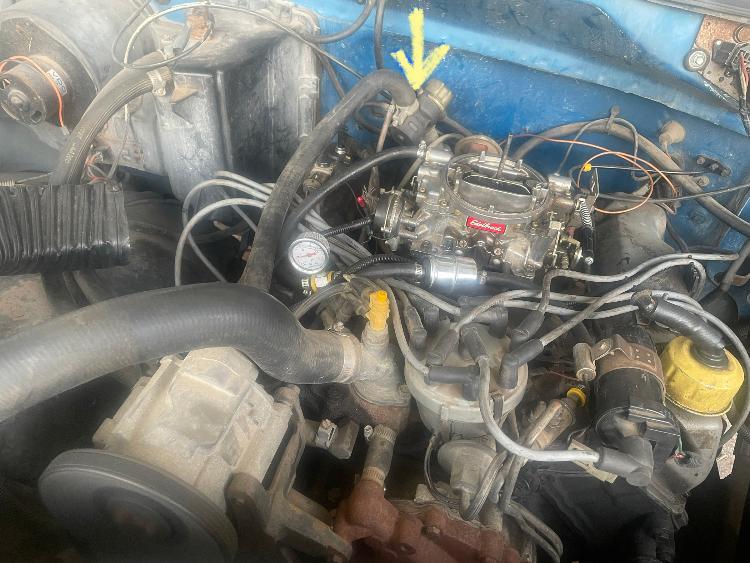
Vivek
- BB 2WD - 1984 F350 RWD 460/C6 - 1978 Bronco with a 460 from an 86 Bullnose/C6 |
Re: 460 is running rich on Edelbrock 1411
|
Administrator
|
The thermactor crossover at the back of the heads pumps oxygen directly into the exhaust ports.
This helps burn off all the raw fuel and carbon monoxide that makes it out the exhaust valve. Obviously this is a lot of wasted energy, and crazy heat in the engine bay. The analogue of how they used to just flare gas off at the well head instead of capturing it and using it for polymer chemistry
Jim,
Lil'Red is a '87 F250 HD, 4.10's, 1356 4x4, Zf-5, 3G, PMGR, Saginaw PS, desmogged with a Holley 80508 and Performer intake. Too much other stuff to mention. |
|
Thanks Jim, I probably should’ve kept the smog on my 78 install but the fit inside the dentside is on the tight side in the rear, I didn’t want to take chances.
I have that entire system though in the parts bin and pretty sure working…
Vivek
- BB 2WD - 1984 F350 RWD 460/C6 - 1978 Bronco with a 460 from an 86 Bullnose/C6 |
|
In reply to this post by ArdWrknTrk
this is one thing that I have not gotten to make sense in my head. it feels a bit contradictory. I get the air injection for burn off. "Fanning the flames" so to speak. yet as I have been told by so many over the years exhaust leaks cause burned valves due to the added air. this seems like "bs" to me and always has. I welcome someone explaining this in a convincing way. exhaust valves are in the flame flow every time they open at all and will get heated whenever not contacting the heatsink that is the seat/head. now I do understand that the thermactor valve switches from feeding air to the cat to feeding air into the head based on load/demand but fail to see how either one can burn valves.
|
Re: 460 is running rich on Edelbrock 1411
|
Administrator
|
I don't think it burns valves, but I DO see how a blast of cold air could warp a valve.
In 460 heads the thermactor passages run right past the exhaust ports (I don't have Scotty's porting templates in front of me, but it's really easy to grind through) I definitely don't think the air is 'cold' by the time it enters the port, and the engine is always running if the pump(s) are turning. Even at 600rpm idle that valve is pushing combustion products out 300x a minute, or 15x every second.
Jim,
Lil'Red is a '87 F250 HD, 4.10's, 1356 4x4, Zf-5, 3G, PMGR, Saginaw PS, desmogged with a Holley 80508 and Performer intake. Too much other stuff to mention. |
|
it seems as though you see it as I
 do. do.
|
|
Installed new auxiliary cooler, not too satisfied with the wonky install, I wanted to make sure it wasn’t right up against the AC condenser and there was a good air gap. But it is secure and functional.
Today it was about 79F ambient and in my opinion the temp numbers below look somewhat high and indicative of a torque converter not at the top of its game ?? 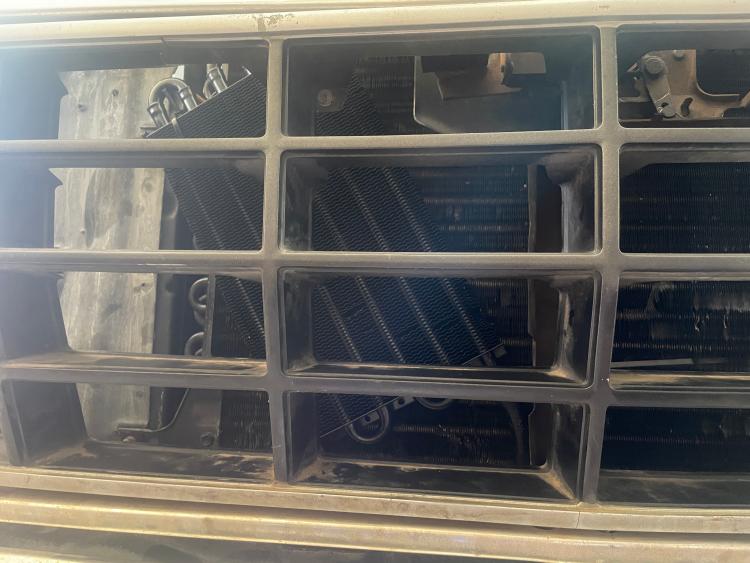 Temp gauge plumbed between the radiator and aux cooler. 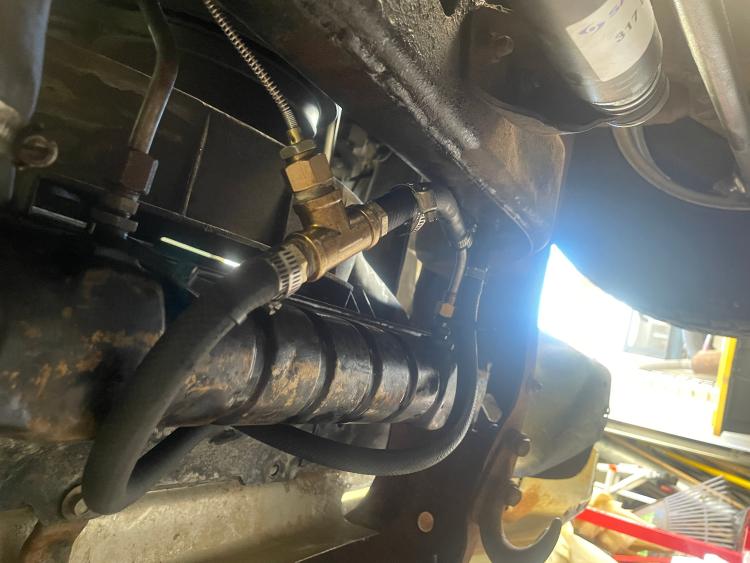 Temp with AC off after driving 5 mins like a loony  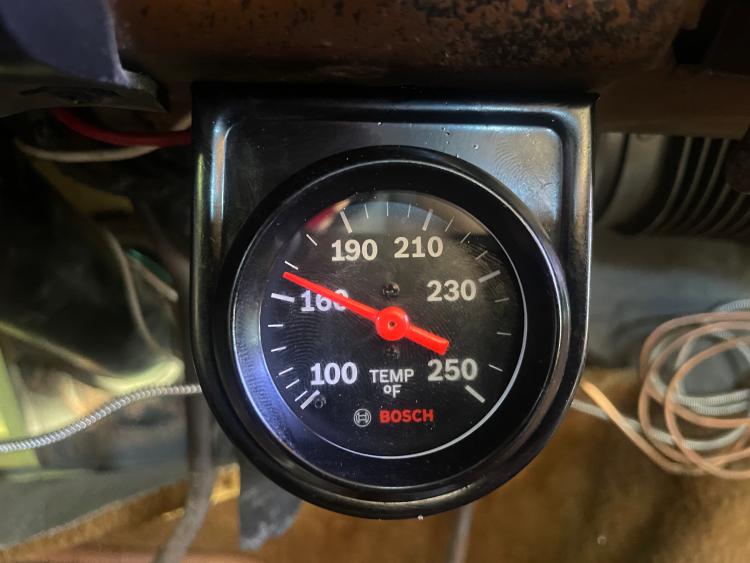 Temp with AC on and driving yet another 5 mins like a reckless teenager  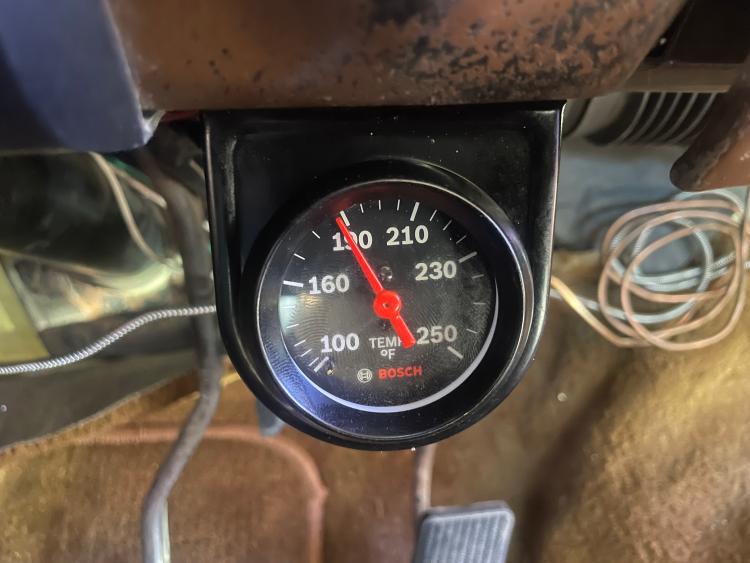 Temp at input cooler line to radiator (215C) 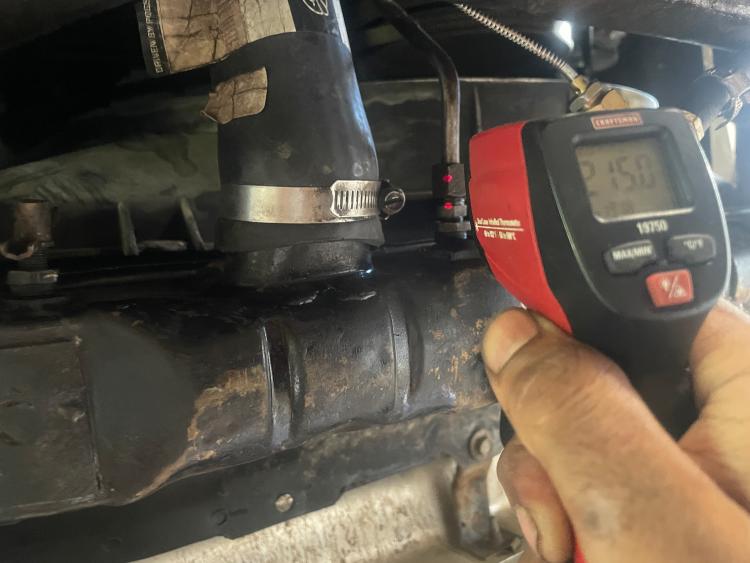 Temp at cooler line going back into transmission (186F) 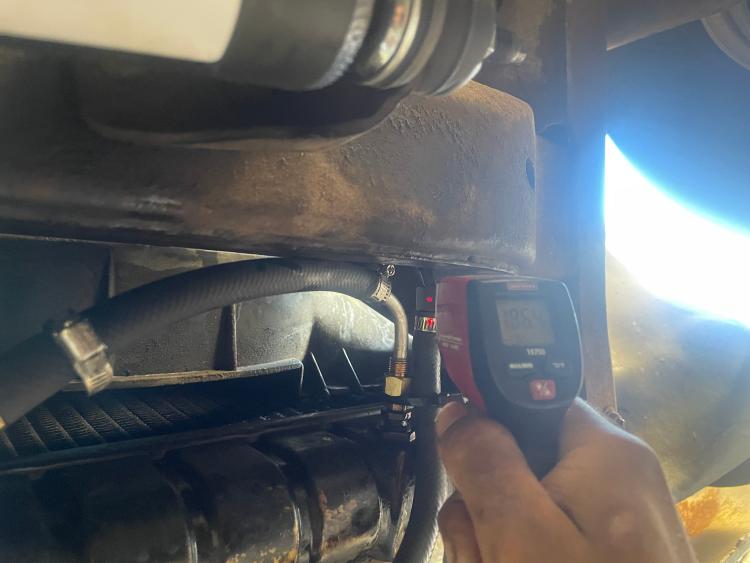
Vivek
- BB 2WD - 1984 F350 RWD 460/C6 - 1978 Bronco with a 460 from an 86 Bullnose/C6 |
Re: 460 is running rich on Edelbrock 1411
|
Administrator
|
Bummer! Internet went down as I posted and I lost the post.
Anyway, a lot depends on how you plumbed it, meaning where the aux cooler is with respect to the gauge and the radiator's cooler. The radiator will eventually get to the temp your thermostat is set to, and even with COLD ATF going into it the ATF coming out will be almost coolant temp. So, how are you plumbed?
Gary, AKA "Gary fellow": Profile
Dad's: '81 F150 Ranger XLT 4x4: Down for restomod: Full-roller "stroked 351M" w/Trick Flow heads & intake, EEC-V SEFI/E4OD/3.50 gears w/Kevlar clutches
|
|
I see... The way its plumbed is shown below... I found this diagram online and I have just added a green circle to show where the temp gauge 'tap' is. It was convenient to tap there as that part is a rubber line.
Unfortunately my temp gauge is post radiator... so the actual fluid temp coming out of the cooler lines is ~20-30F hotter probably and that is what I saw. 190F at the gauge meant approx. 215C on the input cooler line to the radiator. 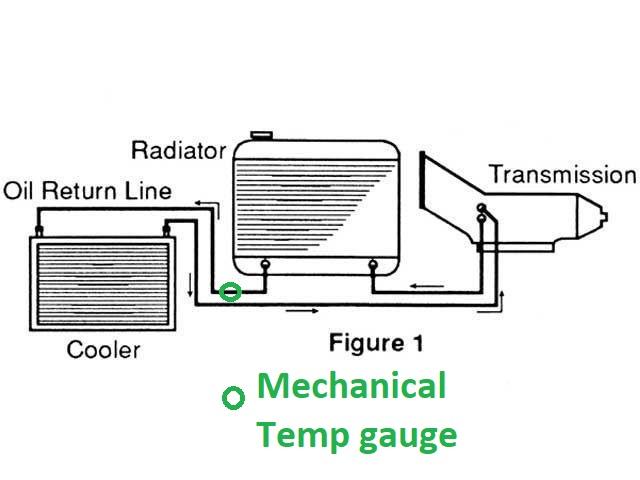
Vivek
- BB 2WD - 1984 F350 RWD 460/C6 - 1978 Bronco with a 460 from an 86 Bullnose/C6 |
Re: 460 is running rich on Edelbrock 1411
|
Administrator
|
I don't think where you are measuring the temp will give you very helpful info. I think I'd want the temp coming right out of the transmission - very similar to where Ford puts the temp sender in the cooling system. That is right ahead of any cooling.
But that's just my thinking. You should see what other say.
Gary, AKA "Gary fellow": Profile
Dad's: '81 F150 Ranger XLT 4x4: Down for restomod: Full-roller "stroked 351M" w/Trick Flow heads & intake, EEC-V SEFI/E4OD/3.50 gears w/Kevlar clutches
|
|
Gary, I agree with that. The way I have it is not representative of actual temp at the transmission pan, I have seen some people add the temp gauge to the transmission pan.
I am hoping if I can baseline it i.e. establish a correlation with a infrared gauge between the actual temp and what the gauge says, I can use it as a 'monitor'.
Vivek
- BB 2WD - 1984 F350 RWD 460/C6 - 1978 Bronco with a 460 from an 86 Bullnose/C6 |
|
Since I have a drain plug, I decided to drop the pan just to check … nothing sinister inside ..
This is after 700 miles 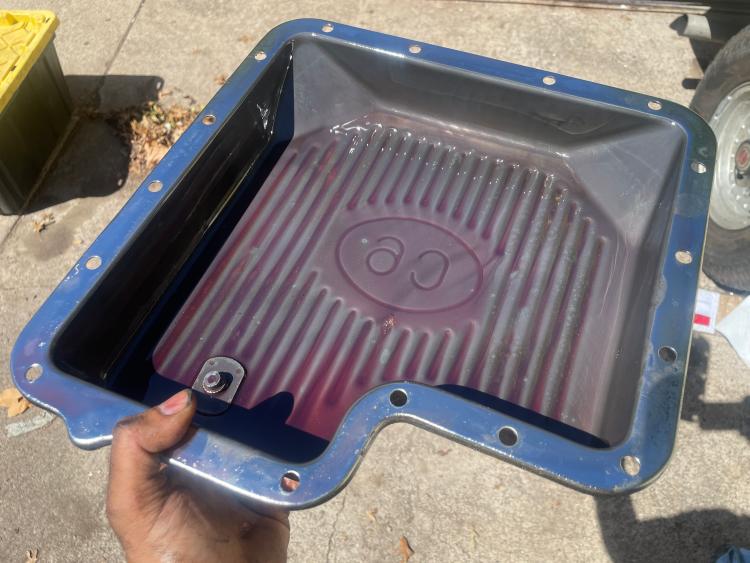 I wiped the pan and it was black stuff that was on the wipe 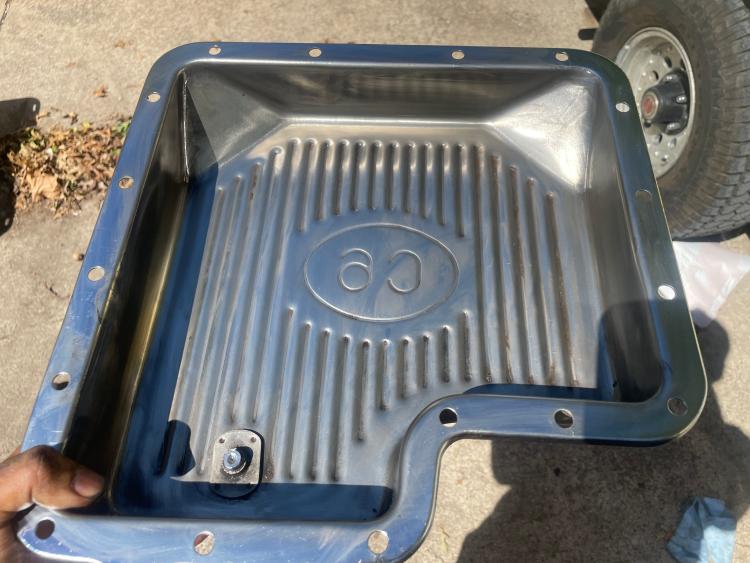
Vivek
- BB 2WD - 1984 F350 RWD 460/C6 - 1978 Bronco with a 460 from an 86 Bullnose/C6 |
|
This post was updated on .
If we think it was just a case of stuck governor, and by adding Lucas, I have made that less like to happen… and I haven’t found anything malicious in the pan… added a cooler now.. just thinking am I long-distance ready?
I do have AAA coverage 
Vivek
- BB 2WD - 1984 F350 RWD 460/C6 - 1978 Bronco with a 460 from an 86 Bullnose/C6 |
|
certainly, it is more representative of trans temp if measuring immediately out of the trans before headed to the cooling system. and that is what the pump, converter. clutches, bands and all valve body are dealing with. the cooled fluid gets pumped right back into the pool so to speak cooling the whole, yet it is not the operating temp.
|
Re: 460 is running rich on Edelbrock 1411
|
Administrator
|
Don't know if you are long distance ready, but put it on the road in the interim?
Gary, AKA "Gary fellow": Profile
Dad's: '81 F150 Ranger XLT 4x4: Down for restomod: Full-roller "stroked 351M" w/Trick Flow heads & intake, EEC-V SEFI/E4OD/3.50 gears w/Kevlar clutches
|
|
Matt, yes, that makes sense. I am definitely leaning on this temp reading as just a means to baseline performance. Today while driving, I saw 215F at the radiator input, about 186F going back into the transmission, and my gauge was roughly at 190F.... so if I see 190F at the gauge, I'm definitely closer to 220F at the transmission pan... which I think is too much unfortunately based on watching modern transmissions. I had a 07 F150 and even towing 7000 lbs I never saw the trans fluid get hotter than 215F.
I don't know if I don't have adequate cooling or if my torque converter isn't doing a good job.... I do not have a good baseline yet from internet search on what is a good temperature for C6. Gary, yes, I believe it would be fine to put things to the test in the meantime locally. I just went on a 15 mile trip (half-highway/half stop and go) and things seem to be doing better than ever actually. I am having less "horsepower" loss while hot, and "gauge" never went above 190F.
Vivek
- BB 2WD - 1984 F350 RWD 460/C6 - 1978 Bronco with a 460 from an 86 Bullnose/C6 |
| Edit this page |

